Anthropogenic NOx Emission Estimations over East China for 2015 and 2019 Using OMI Satellite Observations and the New Inverse Modeling System CIF-CHIMERE
Abstract
1. Introduction
2. Materials and Methods
2.1. Inversion-Related Tools and Data
2.1.1. Inverse Modeling and the CIF System
2.1.2. HTAP v2.2 Emission Inventory
2.1.3. OMI Satellite Observations
2.1.4. The Regional CHIMERE CTM
2.1.5. Inversion Experiments
2.2. Evaluation Data and Method
2.2.1. MEIC Bottom-Up Emission Inventory
2.2.2. CNEMC Ground-Based Observations
2.2.3. Evaluation and Analysis Methodology
3. Results and Discussion
3.1. Evaluation of the CIF-CHIMERE System and NOx Emission Estimates with Ground-Based Measurements
3.2. Analysis of the Estimated Chinese Annual Anthropogenic NOx Emissions in 2015 and 2019
3.3. Analysis of the Estimated Annual Anthropogenic NOx Emissions at Selected Urbanized and Industrialized Locations
3.3.1. Evaluation of the Estimated Annual Anthropogenic NOx Emissions in 2015 and 2019
3.3.2. Monthly Evaluation of the Anthropogenic NOx Emissions
3.3.3. Comparison with In-Situ Stations
4. Conclusions
Supplementary Materials
Author Contributions
Funding
Data Availability Statement
Acknowledgments
Conflicts of Interest
References
- Seinfeld, J.H.; Pandis, S.N. Atmospheric Chemistry and Physics: From Air Pollution to Climate Change; John Wiley & Sons: Hoboken, NJ, USA, 2016. [Google Scholar]
- Ng, N.L.; Chhabra, P.S.; Chan, A.W.H.; Surratt, J.D.; Kroll, J.H.; Kwan, A.J.; McCabe, D.C.; Wennberg, P.O.; Sorooshian, A.; Murphy, S.M.; et al. Effect of NOx level on secondary organic aerosol (SOA) formation from the photooxidation of terpenes. Atmos. Chem. Phys. 2007, 7, 5159–5174. [Google Scholar] [CrossRef]
- Atkinson, R. Atmospheric chemistry of VOCs and NOx. Atmos. Environ. 2000, 34, 2063–2101. [Google Scholar] [CrossRef]
- Houghton, J.T.; Ding, Y.; Griggs, D.J.; Noguer, M.; van der Linden, P.J.; Dai, X.; Maskell, K.; Johnson, C.A. (Eds.) IPCC, 2001: Climate Change 2001: The Scientific Basis. Contribution of Working Group I to the Third Assessment Report of the Intergovernmental Panel on Climate Change; Cambridge University Press: Cambridge, UK; New York, NY, USA, 2001. [Google Scholar]
- Almaraz, M.; Bai, E.; Wang, C.; Trousdell, J.; Conley, S.; Faloona, I.; Houlton, B.Z. Agriculture is a major source of NOx pollution in California. Sci. Adv. 2018, 4, eaao3477. [Google Scholar] [CrossRef] [PubMed]
- Granier, C.; Bessagnet, B.; Bond, T.; D’Angiola, A.; Denier van der Gon, H.; Frost, G.J.; Heil, A.; Kaiser, J.W.; Kinne, S.; Klimont, Z.; et al. Evolution of anthropogenic and biomass burning emissions of air pollutants at global and regional scales during the 1980–2010 period. Clim. Change 2011, 109, 163–190. [Google Scholar] [CrossRef]
- Shaw, S.; Van Heyst, B. Nitrogen Oxide (NOx) emissions as an indicator for sustainability. Environ. Sustain. Indic. 2022, 15, 100–188. [Google Scholar] [CrossRef]
- Jin, Y.; Andersson, H.; Zhang, S. Air Pollution Control Policies in China: A Retrospective and Prospects. Int. J. Environ. Res. Public. Health 2016, 13, 1219. [Google Scholar] [CrossRef]
- de Foy, B.; Lu, Z.; Streets, D.G. Satellite NO2 retrievals suggest China has exceeded its NOx reduction goals from the twelfth Five-Year Plan. Sci. Rep. 2016, 6, 35912. [Google Scholar] [CrossRef]
- CAA (Clean Air Asia). China Air 2016—Air Pollution Prevention and Control Progress in Chinese Cities. 2016. Available online: http://www.allaboutair.cn/a/cbw/bg/2016/0822/472.html (accessed on 4 October 2022).
- Anger, A.; Dessens, O.; Xi, F.; Barker, T.; Wu, R. China’s air pollution reduction efforts may result in an increase in surface ozone levels in highly polluted areas. Ambio 2016, 45, 254–265. [Google Scholar] [CrossRef]
- Notice of the State Council on Printing and Distributing the “13th Five-Year” Ecological and Environmental Protection Plan_Government Information Disclosure Column. Available online: http://www.gov.cn/zhengce/content/2016-12/05/content_5143290.htm (accessed on 25 November 2022).
- Colette, A.; Granier, C.; Hodnebrog, Ø.; Jakobs, H.; Maurizi, A.; Nyiri, A.; Rao, S.; Amann, M.; Bessagnet, B.; d’Angiola, A.; et al. Future air quality in Europe: A multi-model assessment of projected exposure to ozone. Atmos. Chem. Phys. 2012, 12, 10613–10630. [Google Scholar] [CrossRef]
- Zhao, Y.; Zhang, J.; Nielsen, C.P. The effects of energy paths and emission controls and standards on future trends in China’s emissions of primary air pollutants. Atmos. Chem. Phys. 2014, 14, 8849–8868. [Google Scholar] [CrossRef]
- Permadi, D.A.; Kim Oanh, N.T.; Vautard, R. Integrated emission inventory and modeling to assess distribution of particulate matter mass and black carbon composition in Southeast Asia. Atmos. Chem. Phys. 2018, 18, 2725–2747. [Google Scholar] [CrossRef]
- Elguindi, N.; Granier, C.; Stavrakou, T.; Darras, S.; Bauwens, M.; Cao, H.; Chen, C.; Denier van der Gon, H.A.C.; Dubovik, O.; Fu, T.M.; et al. Intercomparison of Magnitudes and Trends in Anthropogenic Surface Emissions From Bottom-Up Inventories, Top-Down Estimates, and Emission Scenarios. Earths Future 2020, 8, e2020EF001520. [Google Scholar] [CrossRef]
- Xia, Y.; Zhao, Y.; Nielsen, C.P. Benefits of China’s efforts in gaseous pollutant control indicated by the bottom-up emissions and satellite observations 2000–2014. Atmos. Environ. 2016, 136, 43–53. [Google Scholar] [CrossRef]
- Shi, Y.; Xia, Y.; Lu, B.; Liu, N.; Zhang, L.; Li, S.; Li, W. Emission inventory and trends of NOx for China, 2000–2020. J. Zhejiang Univ. Sci. A 2014, 15, 454–464. [Google Scholar] [CrossRef]
- Li, M.; Zhang, Q.; Kurokawa, J.; Woo, J.-H.; He, K.; Lu, Z.; Ohara, T.; Song, Y.; Streets, D.G.; Carmichael, G.R.; et al. MIX: A mosaic Asian anthropogenic emission inventory under the international collaboration framework of the MICS-Asia and HTAP. Atmos. Chem. Phys. 2017, 17, 935–963. [Google Scholar] [CrossRef]
- Zheng, B.; Tong, D.; Li, M.; Liu, F.; Hong, C.; Geng, G.; Li, H.; Li, X.; Peng, L.; Qi, J.; et al. Trends in China’s anthropogenic emissions since 2010 as the consequence of clean air actions. Atmos. Chem. Phys. 2018, 18, 14095–14111. [Google Scholar] [CrossRef]
- Zhao, Y.; Zhang, J.; Nielsen, C.P. The effects of recent control policies on trends in emissions of anthropogenic atmospheric pollutants and CO2 in China. Atmos. Chem. Phys. 2013, 13, 487–508. [Google Scholar] [CrossRef]
- Crippa, M.; Guizzardi, D.; Muntean, M.; Schaaf, E.; Dentener, F.; van Aardenne, J.A.; Monni, S.; Doering, U.; Olivier, J.G.J.; Pagliari, V.; et al. Gridded emissions of air pollutants for the period 1970–2012 within EDGAR v4.3.2. Earth Syst. Sci. Data 2018, 10, 1987–2013. [Google Scholar] [CrossRef]
- Ding, J.; Miyazaki, K.; van der A, R.J.; Mijling, B.; Kurokawa, J.; Cho, S.; Janssens-Maenhout, G.; Zhang, Q.; Liu, F.; Levelt, P.F. Intercomparison of NOx emission inventories over East Asia. Atmos. Chem. Phys. 2017, 17, 10125–10141. [Google Scholar] [CrossRef]
- de Foy, B.; Wilkins, J.L.; Lu, Z.; Streets, D.G.; Duncan, B.N. Model evaluation of methods for estimating surface emissions and chemical lifetimes from satellite data. Atmos. Environ. 2014, 98, 66–77. [Google Scholar] [CrossRef]
- Boersma, K.F.; Vinken, G.C.M.; Eskes, H.J. Representativeness errors in comparing chemistry transport and chemistry climate models with satellite UV–Vis tropospheric column retrievals. Geosci. Model Dev. 2016, 9, 875–898. [Google Scholar] [CrossRef]
- Leue, C.; Wenig, M.; Wagner, T.; Klimm, O.; Platt, U.; Jähne, B. Quantitative analysis of NOx emissions from Global Ozone Monitoring Experiment satellite image sequences. J. Geophys. Res. Atmos. 2001, 106, 5493–5505. [Google Scholar] [CrossRef]
- Cooper, M.; Martin, R.V.; Padmanabhan, A.; Henze, D.K. Comparing mass balance and adjoint methods for inverse modeling of nitrogen dioxide columns for global nitrogen oxide emissions. J. Geophys. Res. Atmos. 2017, 122, 4718–4734. [Google Scholar] [CrossRef]
- Han, K.M.; Kim, H.S.; Song, C.H. An Estimation of Top-Down NOx Emissions from OMI Sensor Over East Asia. Remote Sens. 2020, 12, 2004. [Google Scholar] [CrossRef]
- Itahashi, S.; Yumimoto, K.; Kurokawa, J.; Morino, Y.; Nagashima, T.; Miyazaki, K.; Maki, T.; Ohara, T. Inverse estimation of NOx emissions over China and India 2005–2016: Contrasting recent trends and future perspectives. Environ. Res. Lett. 2019, 14, 124020. [Google Scholar] [CrossRef]
- Martin, R.V. Global inventory of nitrogen oxide emissions constrained by space-based observations of NO2 columns. J. Geophys. Res. 2003, 108, 4537. [Google Scholar] [CrossRef]
- Napelenok, S.L.; Pinder, R.W.; Gilliland, A.B.; Martin, R.V. A method for evaluating spatially-resolved NOx emissions using Kalman filter inversion, direct sensitivities, and space-based NO2 observations. Atmos. Chem. Phys. 2008, 8, 5603–5614. [Google Scholar] [CrossRef]
- Kurokawa, J.; Yumimoto, K.; Uno, I.; Ohara, T. Adjoint inverse modeling of NOx emissions over eastern China using satellite observations of NO2 vertical column densities. Atmos. Environ. 2009, 43, 1878–1887. [Google Scholar] [CrossRef]
- van der A, R.J.; Mijling, B.; Ding, J.; Koukouli, M.E.; Liu, F.; Li, Q.; Mao, H.; Theys, N. Cleaning up the air: Effectiveness of air quality policy for SO2 and NOx emissions in China. Atmos. Chem. Phys. 2017, 17, 1775–1789. [Google Scholar] [CrossRef]
- Mijling, B.; van der A, R.J. Using daily satellite observations to estimate emissions of short-lived air pollutants on a mesoscopic scale. J. Geophys. Res. Atmos. 2012, 117, D17. [Google Scholar] [CrossRef]
- Ding, J.; van der A, R.J.; Mijling, B.; Levelt, P.F.; Hao, N. NOx emission estimates during the 2014 Youth Olympic Games in Nanjing. Atmos. Chem. Phys. 2015, 15, 9399–9412. [Google Scholar] [CrossRef]
- Menut, L.; Bessagnet, B.; Khvorostyanov, D.; Beekmann, M.; Blond, N.; Colette, A.; Coll, I.; Curci, G.; Foret, G.; Hodzic, A.; et al. CHIMERE 2013: A model for regional atmospheric composition modelling. Geosci. Model Dev. 2013, 6, 981–1028. [Google Scholar] [CrossRef]
- Li, M.; Liu, H.; Geng, G.; Hong, C.; Liu, F.; Song, Y.; Tong, D.; Zheng, B.; Cui, H.; Man, H.; et al. Anthropogenic emission inventories in China: A review. Natl. Sci. Rev. 2017, 4, 834–866. [Google Scholar] [CrossRef]
- MEIC. Available online: http://meicmodel.org/?page_id=541&lang=en (accessed on 27 September 2022).
- Boersma, K.F.; Eskes, H.J.; Dirksen, R.J.; van der A, R.J.; Veefkind, J.P.; Stammes, P.; Huijnen, V.; Kleipool, Q.L.; Sneep, M.; Claas, J.; et al. An improved tropospheric NO2 column retrieval algorithm for the Ozone Monitoring Instrument. Atmos. Meas. Tech. 2011, 4, 1905–1928. [Google Scholar] [CrossRef]
- Qu, Z.; Henze, D.K.; Worden, H.M.; Jiang, Z.; Gaubert, B.; Theys, N.; Wang, W. Sector-Based Top-Down Estimates of NOx, SO2, and CO Emissions in East Asia. Geophys. Res. Lett. 2022, 49, e2021GL096009. [Google Scholar] [CrossRef] [PubMed]
- Janssens-Maenhout, G.; Crippa, M.; Guizzardi, D.; Dentener, F.; Muntean, M.; Pouliot, G.; Keating, T.; Zhang, Q.; Kurokawa, J.; Wankmüller, R.; et al. HTAP_v2.2: A mosaic of regional and global emission grid maps for 2008 and 2010 to study hemispheric transport of air pollution. Atmos. Chem. Phys. 2015, 15, 11411–11432. [Google Scholar] [CrossRef]
- Henze, D.K.; Hakami, A.; Seinfeld, J.H. Development of the adjoint of GEOS-Chem. Atmos Chem Phys 2007, 7, 2413–2433. [Google Scholar] [CrossRef]
- Berchet, A.; Sollum, E.; Thompson, R.L.; Pison, I.; Thanwerdas, J.; Broquet, G.; Chevallier, F.; Aalto, T.; Berchet, A.; Bergamaschi, P.; et al. The Community Inversion Framework v1.0: A unified system for atmospheric inversion studies. Geosci. Model Dev. 2021, 14, 5331–5354. [Google Scholar] [CrossRef]
- Fortems-Cheiney, A.; Pison, I.; Broquet, G.; Dufour, G.; Berchet, A.; Potier, E.; Coman, A.; Siour, G.; Costantino, L. Variational regional inverse modeling of reactive species emissions with PYVAR-CHIMERE-v2019. Geosci. Model Dev. 2021, 14, 2939–2957. [Google Scholar] [CrossRef]
- Bocquet, M.; Elbern, H.; Eskes, H.; Hirtl, M.; Žabkar, R.; Carmichael, G.R.; Flemming, J.; Inness, A.; Pagowski, M.; Pérez Camaño, J.L.; et al. Data assimilation in atmospheric chemistry models: Current status and future prospects for coupled chemistry meteorology models. Atmos. Chem. Phys. 2015, 15, 5325–5358. [Google Scholar] [CrossRef]
- Gilbert, J.C.; Lemaréchal, C. Some numerical experiments with variable-storage quasi-Newton algorithms. Math. Program. 1989, 45, 407–435. [Google Scholar] [CrossRef]
- Rayner, P.J.; Michalak, A.M.; Chevallier, F. Fundamentals of data assimilation applied to biogeochemistry. Atmos. Chem. Phys. 2019, 19, 13911–13932. [Google Scholar] [CrossRef]
- Galmarini, S.; Koffi, B.; Solazzo, E.; Keating, T.; Hogrefe, C.; Schulz, M.; Benedictow, A.; Griesfeller, J.J.; Janssens-Maenhout, G.; Carmichael, G.; et al. Technical note: Coordination and harmonization of the multi-scale, multi-model activities HTAP2, AQMEII3, and MICS-Asia3: Simulations, emission inventories, boundary conditions, and model output formats. Atmos. Chem. Phys. 2017, 17, 1543–1555. [Google Scholar] [CrossRef] [PubMed]
- Guenther, A.B.; Jiang, X.; Heald, C.L.; Sakulyanontvittaya, T.; Duhl, T.; Emmons, L.K.; Wang, X. The Model of Emissions of Gases and Aerosols from Nature version 2.1 (MEGAN2.1): An extended and updated framework for modeling biogenic emissions. Geosci. Model Dev. 2012, 5, 1471–1492. [Google Scholar] [CrossRef]
- Müller, J.-F.; Stavrakou, T. Inversion of CO and NOx emissions using the adjoint of the IMAGES model. Atmos. Chem. Phys. 2005, 5, 1157–1186. [Google Scholar] [CrossRef]
- Schoeberl, M.R.; Douglass, A.R.; Hilsenrath, E.; Bhartia, P.K.; Beer, R.; Waters, J.W.; Gunson, M.R.; Froidevaux, L.; Gille, J.C.; Barnett, J.J.; et al. Overview of the EOS aura mission. IEEE Trans. Geosci. Remote Sens. 2006, 44, 1066–1074. [Google Scholar] [CrossRef]
- Levelt, P.F.; van den Oord, G.H.J.; Dobber, M.R.; Malkki, A.; Huib, V.; de Vries, J.; Stammes, P.; Lundell, J.O.V.; Saari, H. The ozone monitoring instrument. IEEE Trans. Geosci. Remote Sens. 2006, 44, 1093–1101. [Google Scholar] [CrossRef]
- Boersma, K.F.; Eskes, H.J.; Richter, A.; De Smedt, I.; Lorente, A.; Beirle, S.; van Geffen, J.H.G.M.; Zara, M.; Peters, E.; Van Roozendael, M.; et al. Improving algorithms and uncertainty estimates for satellite NO2 retrievals: Results from the quality assurance for the essential climate variables (QA4ECV) project. Atmos. Meas. Tech. 2018, 11, 6651–6678. [Google Scholar] [CrossRef]
- Zara, M.; Boersma, K.F.; De Smedt, I.; Richter, A.; Peters, E.; van Geffen, J.H.G.M.; Beirle, S.; Wagner, T.; Van Roozendael, M.; Marchenko, S.; et al. Improved slant column density retrieval of nitrogen dioxide and formaldehyde for OMI and GOME-2A from QA4ECV: Intercomparison, uncertainty characterisation, and trends. Atmos. Meas. Tech. 2018, 11, 4033–4058. [Google Scholar] [CrossRef]
- Lorente, A.; Folkert Boersma, K.; Yu, H.; Dörner, S.; Hilboll, A.; Richter, A.; Liu, M.; Lamsal, L.N.; Barkley, M.; De Smedt, I.; et al. Structural uncertainty in air mass factor calculation for NO2 and HCHO satellite retrievals. Atmos. Meas. Tech. 2017, 10, 759–782. [Google Scholar] [CrossRef]
- Boersma, K.F.; Eskes, H.; Richter, A.; De Smedt, I.; Lorente, A.; Beirle, S.; Van Geffen, J.; Peters, E.; Van Roozendael, M.; Wagner, T. QA4ECV NO2 Tropospheric and Stratospheric Column Data from OMI 2017. Available online: www.qa4ecv.eu/ecv/no2-pre/data (accessed on 9 January 2023).
- TEMIS—Regional Tropospheric NO2 Columns from OMI—Archive. Available online: https://www.temis.nl/airpollution/no2col/no2regioomi_qa.php (accessed on 26 September 2022).
- CHIMERE Chemistry-Transport Model. Available online: https://www.lmd.polytechnique.fr/chimere/ (accessed on 26 September 2022).
- Hauglustaine, D.A.; Hourdin, F.; Jourdain, L.; Filiberti, M.-A.; Walters, S.; Lamarque, J.-F.; Holland, E.A. Interactive chemistry in the Laboratoire de Météorologie Dynamique general circulation model: Description and background tropospheric chemistry evaluation: INTERACTIVE CHEMISTRY IN LMDZ. J. Geophys. Res. Atmos. 2004, 109, D04314. [Google Scholar] [CrossRef]
- Zheng, B.; Zhang, Q.; Geng, G.; Chen, C.; Shi, Q.; Cui, M.; Lei, Y.; He, K. Changes in China’s anthropogenic emissions and air quality during the COVID-19 pandemic in 2020. Earth Syst. Sci. Data 2021, 13, 2895–2907. [Google Scholar] [CrossRef]
- Lamsal, L.N.; Martin, R.V.; van Donkelaar, A.; Steinbacher, M.; Celarier, E.A.; Bucsela, E.; Dunlea, E.J.; Pinto, J.P. Ground-level nitrogen dioxide concentrations inferred from the satellite-borne Ozone Monitoring Instrument. J. Geophys. Res. 2008, 113, D16308. [Google Scholar] [CrossRef]
- Lachatre, M.; Foret, G.; Laurent, B.; Siour, G.; Cuesta, J.; Dufour, G.; Meng, F.; Tang, W.; Zhang, Q.; Beekmann, M. Air Quality Degradation by Mineral Dust over Beijing, Chengdu and Shanghai Chinese Megacities. Atmosphere 2020, 11, 708. [Google Scholar] [CrossRef]
- Flemming, J.; Stern, R.; Yamartino, R. A new air quality regime classification scheme for O, NO, SO and PM10 observations sites. Atmos. Environ. 2005, 39, 6121–6129. [Google Scholar] [CrossRef]
- Liu, F.; van der A, R.J.; Eskes, H.; Ding, J.; Mijling, B. Evaluation of modeling NO2 concentrations driven by satellite-derived and bottom-up emission inventories using in situ measurements over China. Atmos. Chem. Phys. 2018, 18, 4171–4186. [Google Scholar] [CrossRef]

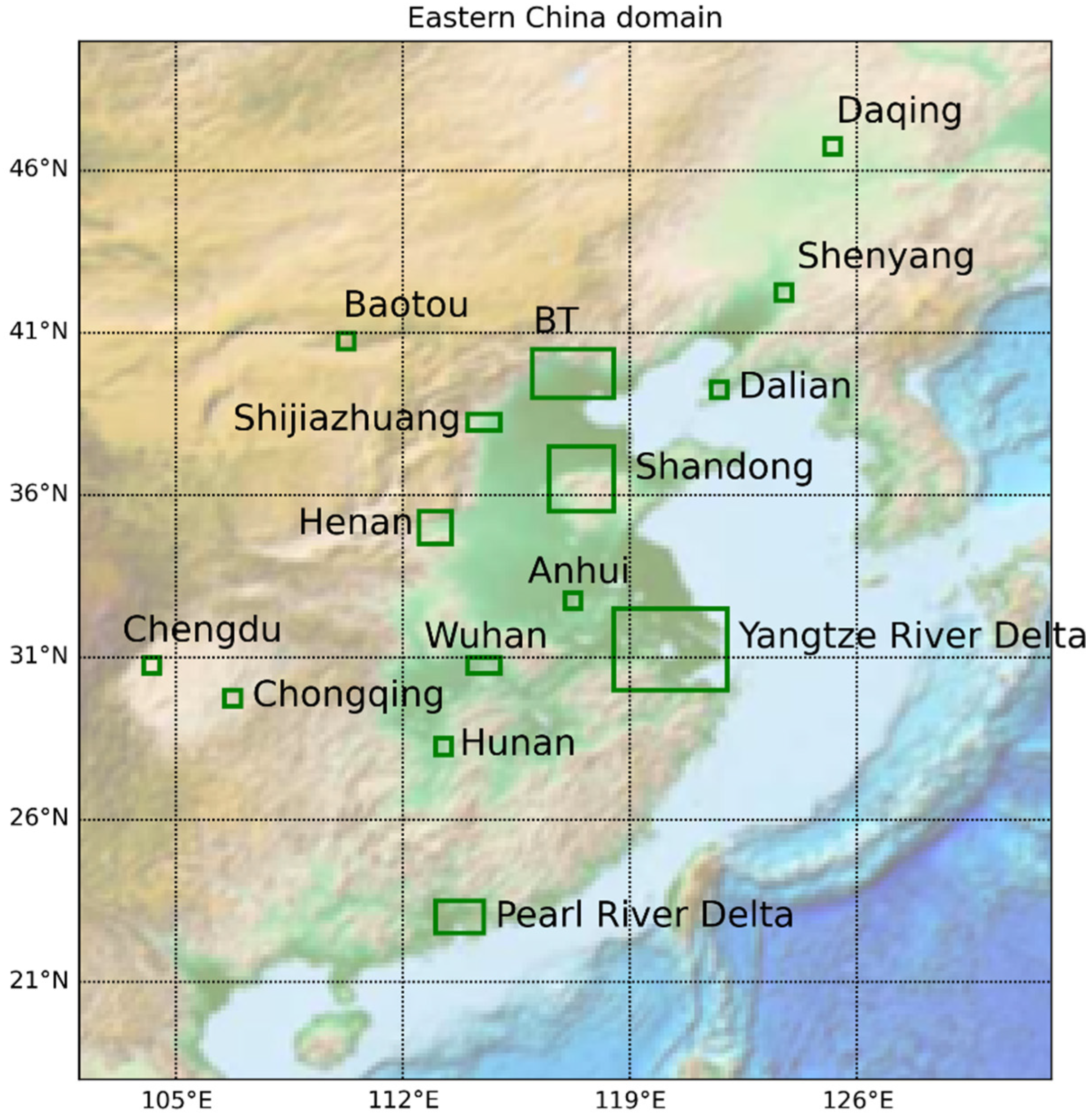


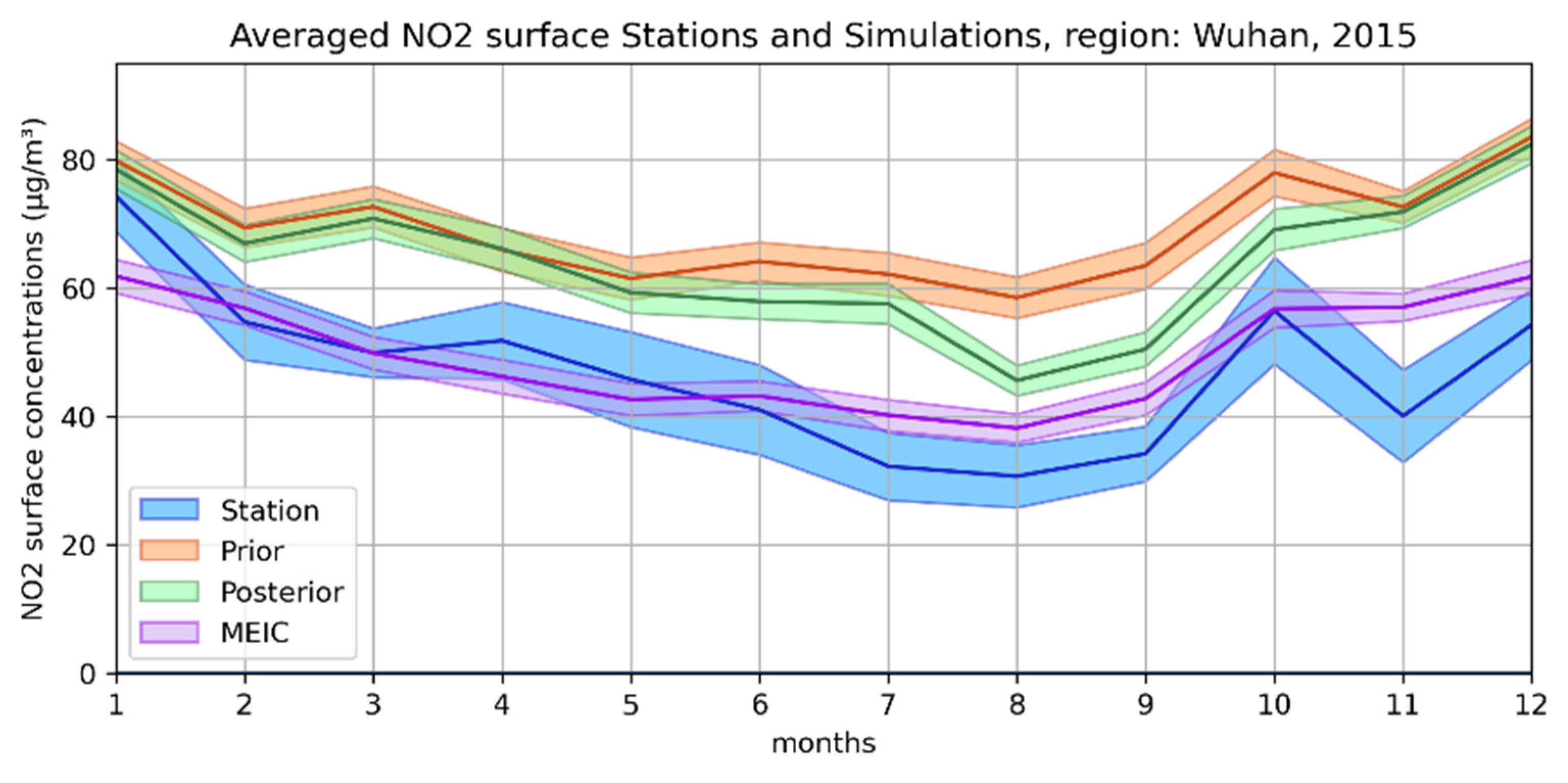
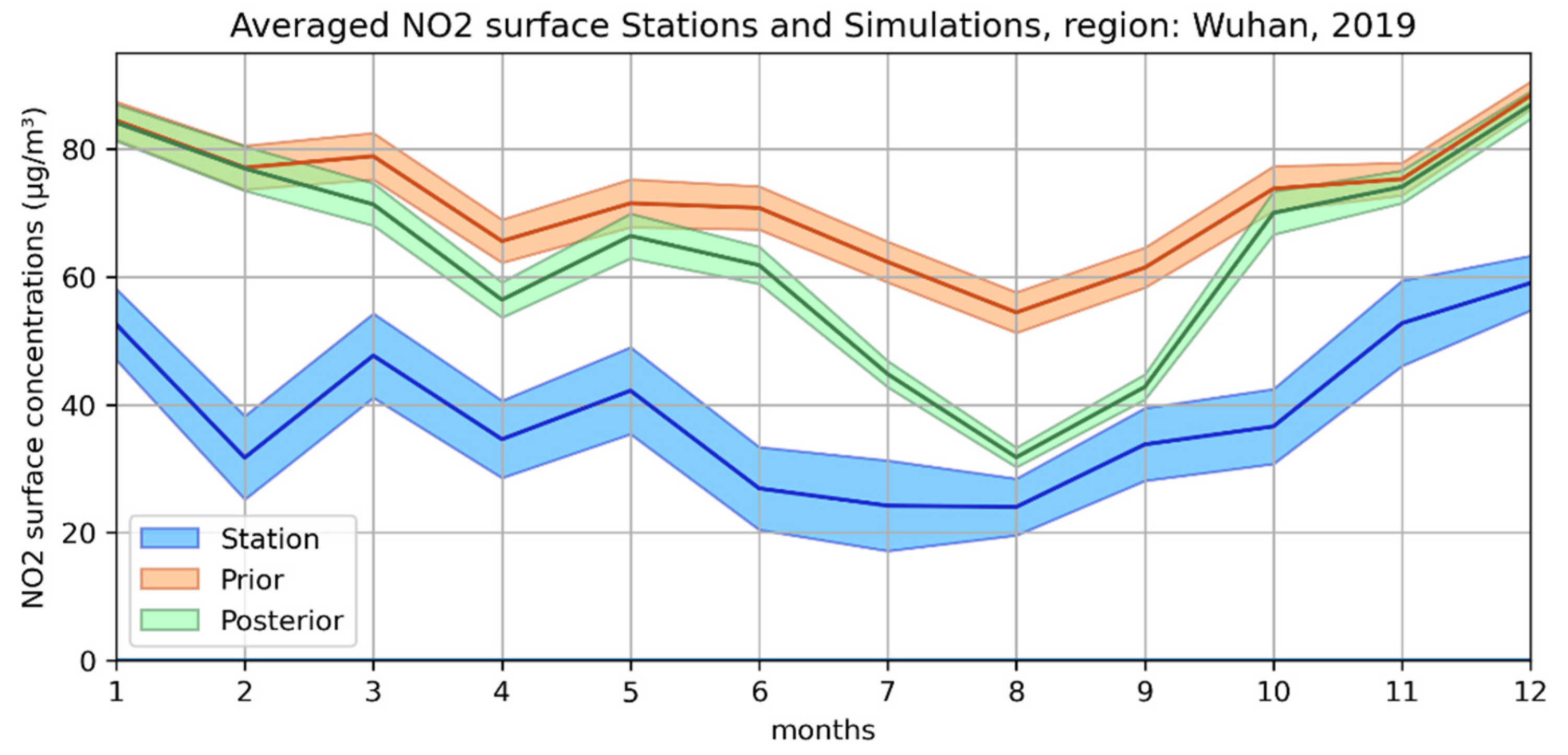
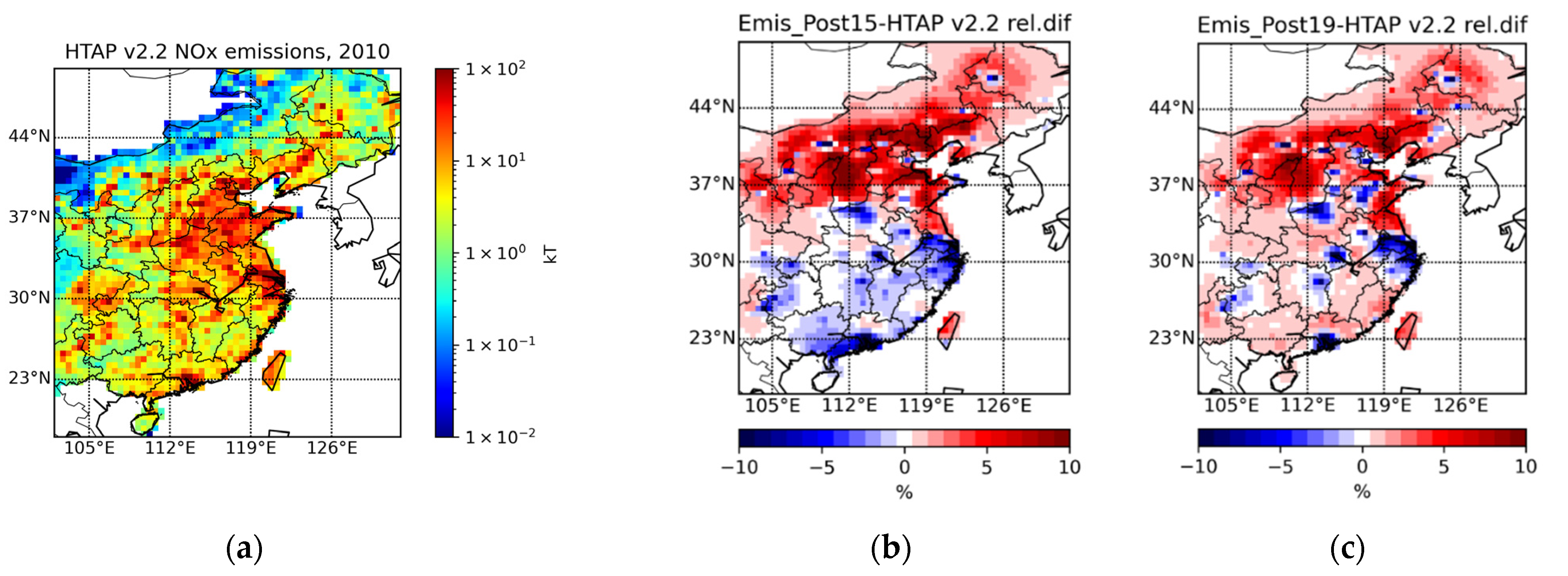
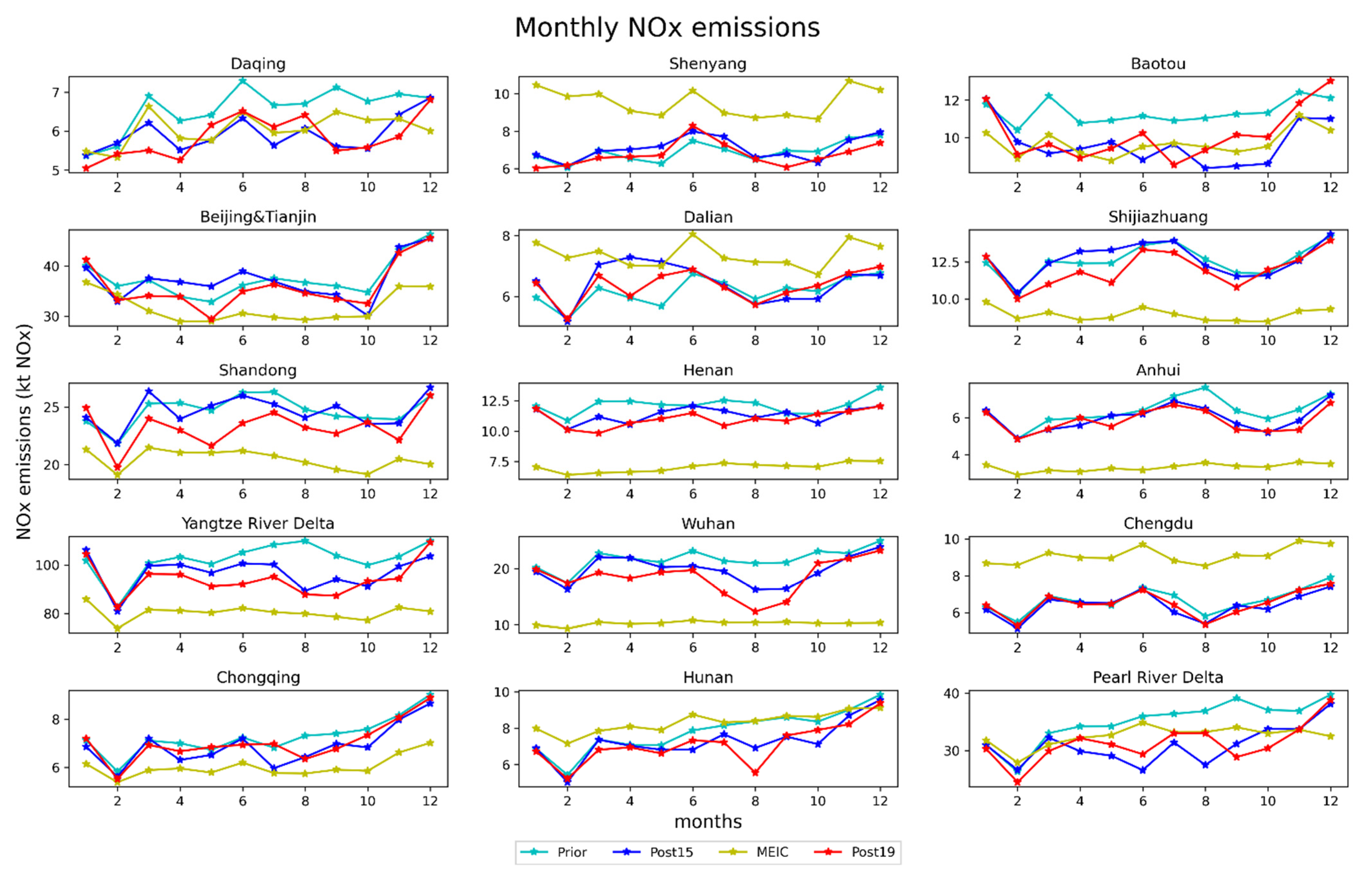
| Type | Target Year | Emission Inventory | Objective | Output |
|---|---|---|---|---|
| Inversion | 2015 | HTAP v2.2 2010 | Estimate monthly anthropogenic NOx Emissions | Emis_Post15 |
| Inversion | 2019 | HTAP v2.2 2010 | Estimate monthly anthropogenic NOx Emissions | Emis_Post19 |
| Control | 2015 | HTAP v2.2 2010 | Simulate hourly NO2 Concentrations | Conc_Prior15 |
| Control | 2019 | HTAP v2.2 2010 | Simulate hourly NO2 Concentrations | Conc_Prior19 |
| Experiment | 2015 | Emis_Post15 | Simulate hourly NO2 Concentrations | Conc_Post15 |
| Experiment | 2019 | Emis_Post19 | Simulate hourly NO2 Concentrations | Conc_Post19 |
| Evaluation | 2015 | MEIC v1.3 for NOx + HTAP v2.2 for other species | Simulate hourly NO2 Concentrations | Conc_MEIC15 |
| Station | Conc_Prior | Conc_Post | Conc_MEIC | ||||||||||||||
|---|---|---|---|---|---|---|---|---|---|---|---|---|---|---|---|---|---|
| Year | Mean | SD | Mean | SD | r | NMB | RMSE | Mean | SD | r | NMB | RMSE | Mean | SD | r | NMB | RMSE |
| 2015 | 27.4 | 11.6 | 29.2 | 18.6 | 0.63 | 7 | 22.1 | 28.8 | 18.1 | 0.64 | 5 | 21.6 | 25.5 | 15.8 | 0.62 | −7 | 20.6 |
| 2019 | 24.8 | 9.8 | 30.3 | 19.2 | 0.67 | 22 | 21.9 | 29.5 | 18.2 | 0.68 | 19 | 20.8 | |||||
| Inventory | East China | Domain—Figure 2 |
|---|---|---|
| HTAP 2010 | 18.6 | 20.5 |
| Emis_Post15 (this study) | 18.5 | 20.4 |
| Emis_Post19 (this study) | 18.4 | 20.3 |
| MEIC15 | 16.4 | - |
| DECSO15 [64] | - | 21.5 |
| Location | Latitude & Longitude | HTAP v2.2 (kt) | Emis_Post15 (kt) | MEIC15 (kt) | Emis_Post19 (kt) |
|---|---|---|---|---|---|
| Daqing | 46–47° N, 124–125.5° E | 78.9 | 71 | 72.5 | 70.1 |
| Shenyang | 41–44° N, 123–125° E | 82.8 | 84.9 | 114.5 | 81.1 |
| Baotou | 40–42° N, 108–111° E | 136.3 | 116.2 | 116.4 | 122.3 |
| Beijing-Tianjin | 38–41° N, 115–118.5° E | 450.8 | 447.3 | 381.2 | 431.7 |
| Dalian | 38–41° N, 120–122° E | 74.2 | 77.4 | 88.4 | 76.3 |
| Shijiazhuang | 37–39° N, 113–115° E | 151.1 | 152.2 | 107.2 | 144.5 |
| Shandong | 35–38° N, 115–119° E | 296.6 | 295.8 | 245.4 | 279.2 |
| Henan | 34–37° N, 112–114° E | 145.5 | 136 | 84.2 | 132.2 |
| Anhui | 32–33° N, 116–118° E | 76.4 | 71.8 | 39.8 | 70.1 |
| Yangtze River Delta | 29–32° N, 118–122° E | 1229.4 | 1162.1 | 963.8 | 1129.8 |
| Wuhan | 29–32° N, 113–116° E | 260.7 | 237.8 | 123.2 | 222 |
| Chengdu | 30–32° N, 103–105° E | 79.9 | 76.7 | 109.2 | 77.9 |
| Chongqing | 29–30° N, 106–107° E | 87.4 | 82.6 | 72.3 | 84.5 |
| Hunan | 27–28° N, 112–113° E | 94.1 | 87.5 | 99.9 | 85.6 |
| Pearl River Delta | 22–24° N, 112–115° E | 420.8 | 370.9 | 390 | 375 |
Disclaimer/Publisher’s Note: The statements, opinions and data contained in all publications are solely those of the individual author(s) and contributor(s) and not of MDPI and/or the editor(s). MDPI and/or the editor(s) disclaim responsibility for any injury to people or property resulting from any ideas, methods, instructions or products referred to in the content. |
© 2023 by the authors. Licensee MDPI, Basel, Switzerland. This article is an open access article distributed under the terms and conditions of the Creative Commons Attribution (CC BY) license (https://creativecommons.org/licenses/by/4.0/).
Share and Cite
Savas, D.; Dufour, G.; Coman, A.; Siour, G.; Fortems-Cheiney, A.; Broquet, G.; Pison, I.; Berchet, A.; Bessagnet, B. Anthropogenic NOx Emission Estimations over East China for 2015 and 2019 Using OMI Satellite Observations and the New Inverse Modeling System CIF-CHIMERE. Atmosphere 2023, 14, 154. https://doi.org/10.3390/atmos14010154
Savas D, Dufour G, Coman A, Siour G, Fortems-Cheiney A, Broquet G, Pison I, Berchet A, Bessagnet B. Anthropogenic NOx Emission Estimations over East China for 2015 and 2019 Using OMI Satellite Observations and the New Inverse Modeling System CIF-CHIMERE. Atmosphere. 2023; 14(1):154. https://doi.org/10.3390/atmos14010154
Chicago/Turabian StyleSavas, Dilek, Gaëlle Dufour, Adriana Coman, Guillaume Siour, Audrey Fortems-Cheiney, Grégoire Broquet, Isabelle Pison, Antoine Berchet, and Bertrand Bessagnet. 2023. "Anthropogenic NOx Emission Estimations over East China for 2015 and 2019 Using OMI Satellite Observations and the New Inverse Modeling System CIF-CHIMERE" Atmosphere 14, no. 1: 154. https://doi.org/10.3390/atmos14010154
APA StyleSavas, D., Dufour, G., Coman, A., Siour, G., Fortems-Cheiney, A., Broquet, G., Pison, I., Berchet, A., & Bessagnet, B. (2023). Anthropogenic NOx Emission Estimations over East China for 2015 and 2019 Using OMI Satellite Observations and the New Inverse Modeling System CIF-CHIMERE. Atmosphere, 14(1), 154. https://doi.org/10.3390/atmos14010154








